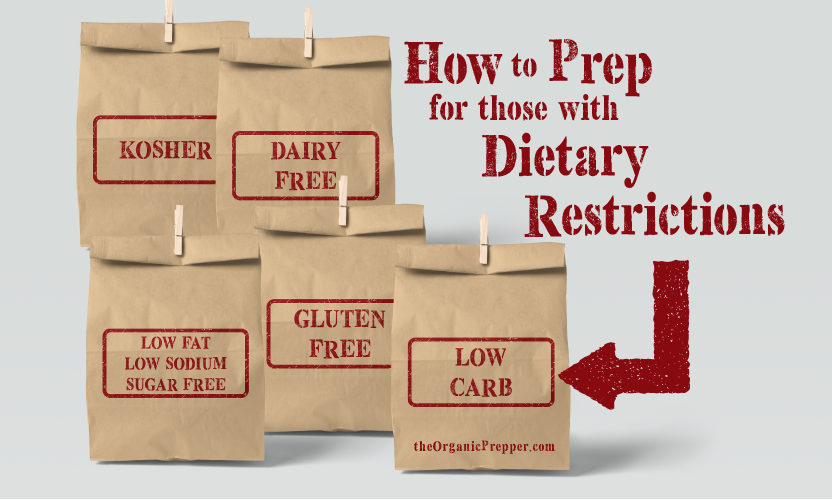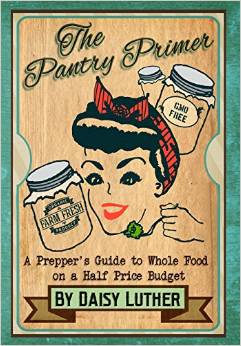If you're new here, you may want to subscribe to my RSS feed. Thanks for visiting!
By Daisy Luther
Excerpt from The Pantry Primer: A Prepper’s Guide to Whole Food on a Half-Price Budget
***
Another important consideration when building your pantry is the restrictions of family members with food-related issues.
There are many people who must eliminate certain foods or suffer the consequence. Allergies and intolerances are a primary issue for the families of sufferers.
Allergies
Prepping for a family member with food allergies can be as easy as stocking alternatives for the person, or as difficult as having to keep the offending ingredient out of the supply altogether.
In the event of a life-threatening allergy, you may want to completely banish the ingredient from your home. Anaphylactic shock requires quick medical intervention, which might not be available or accessible during a disaster. At the very least, be sure to have up-to-date epi-pens, cortisone, and antihistamines on hand.
[page_section template=’3′ position=’default’]
Do you want to prep but you’re not sure how to get started?

[thrive_link color=’teal’ link=’https://preppersuniversity.com/learn-about-the-prepping-intensive-courses/’ target=’_blank’ size=’big’ align=’aligncenter’]Which Prepping Intensive Course Is Right For Me?[/thrive_link]
[/page_section]
Dairy Intolerance
Dairy intolerance (also known as lacto-intolerance) is rarely life-threatening but can make sufferers feel terrible. Many people purchase expensive, highly processed non-dairy milks from the store, but another option is to learn to make your own non-dairy milks from pantry ingredients. If this is your plan, be sure to stock up on supplies like rice or almonds.
Complete directions for making rice milk and almond milk can be found in Section VI
Gluten Intolerance and Celiac Disease
There is an almost epidemic hierarchy of wheat-related ailments in America today. At the pinnacle of this is Celiac disease. Sufferers are highly sensitive to gluten in any form.
The Celiac Disease Foundation explains:
Celiac disease is an autoimmune disorder that can occur in genetically predisposed people where the ingestion of gluten leads to damage in the small intestine. It is estimated to affect 1 in 100 people worldwide. Two and one-half million Americans are undiagnosed and are at risk for long-term health complications.
When people with celiac disease eat gluten (a protein found in wheat, rye and barley), their body mounts an immune response that attacks the small intestine. These attacks lead to damage on the villi, small fingerlike projections that line the small intestine, that promote nutrient absorption. When the villi get damaged, nutrients cannot be absorbed properly into the body.
The disorder can cause serious long-term health effects and those with celiac disease should never consume gluten, even in moderation.
Not quite as severe, but still highly uncomfortable, is gluten intolerance. People with gluten intolerance can have anywhere from mild to severe reactions to the consumption of gluten. Issues can include digestive upset, bloating, aching joints, skin problems, and a host of other symptoms.
Many of the food storage guides recommend storing hundreds of pounds of wheat and flour, but if your family has a member with adverse reactions to gluten, it’s wise to focus your purchasing dollars on grains that are gluten free, like rice, organic corn, quinoa, and oats. Depending on the level of sensitivity, you may need to purchase these from a gluten-free processing facility.
High Blood Pressure, High Cholesterol, and Heart Disease
For those with high blood pressure, heart disease, or high cholesterol, it is important to stock food that is less processed. Many processed foods contain high levels of sodium and saturated fats, both of which can be a cause for concern if you have a family member with these health issues. Sodium can send the blood pressure skyrocketing.
Keep in mind that during a time when you are reliant on your pantry, a prescription that keeps the person’s reactions to these foods under control may not be readily available. It’s imperative that their diet not exacerbate the issue.
Avoid or limit the following foods when stockpiling for a family member with one of these conditions:
- Hydrogenated oils (these are usually found in highly processed foods)
- High sodium foods (better to add salt as needed)
- Sugar/Carbohydrates (Sugar and refined carbohydrates have been proven to elevate triglyceride levels. This can result in cardiac issues or fatty liver disease)
Stock up on storage foods in the purest form possible for a family member with any of these conditions. Focus on lean meats, vegetables, fruits, and whole grains.
Diabetes
Who can forget the powerful storyline in the eye-opening book One Second After about the girl who was an insulin dependent diabetic? Particularly in the event of a longer-term emergency, prepping carefully for a family member with diabetes can be a life-or-death matter.
As this book is about food pantries and I’m not a medical professional, I can’t advise you about the specific medical concerns for diabetics. I can recommend an excellent series on the topic that is available online from Joe Alton, MD (Dr. Bones). You can find the articles at the following web addresses:
- http://www.doomandbloom.net/diabetes-in-survival-settings-part-1/
- http://www.doomandbloom.net/diabetes-and-survival-part-2-type-1-prevention/
- http://www.doomandbloom.net/diabetes-and-survival-part-3-type-2-prevention/
- http://www.doomandbloom.net/diabetes-and-survival-part-4-treatment/
- http://www.doomandbloom.net/diabetes-and-survival-part-5-natural-remedies/
As far as your pantry is concerned, it’s important to understand how a diabetic processes food. Carbohydrates are processed in about the same way as pure sugar, and can wreak havoc on blood sugar levels. This means that a large stockpile of grains will usable for the diabetic family member.
The following recommendations are for surviving a crisis and are not necessarily recommendations for everyday life when supplies are easy to acquire.
- The ideal diet for a Type 1 diabetic during a crisis situation in which the availability of insulin is in question would be focused on proteins and fats, with as few carbohydrates as possible. Keep the caloric intake fairly low, and spread the food across 6 small meals throughout the day.
- For a Type 2 diabetic, the ideal diet during a crisis is a bit different. Plan for small frequent meals that are high in fiber, low in fat, and low in carbohydrates. Be sure that the diabetic person remains active.
Both of these suggested diets mean that your stockpile should have additional focus on high-quality protein for the diabetic family member, as well as options that are low in carbohydrates. The grain-filled pantry could be a death sentence for a diabetic family member.
Vegan/Vegetarian
A vegetarian does not eat the flesh of animals, but may consume dairy products or eggs. A vegan does not consume any products that have come from animals, including honey.
If you have a family member who is vegan or vegetarian, be sure to accommodate them with protein sources that do not contain meat, such as beans, grains, legumes, seeds, and nuts. A variety of plant proteins are needed in order to provide the amino acids necessary for good nutrition. Quinoa, in particular, is an excellent non-meat source of protein and amino acids. The bonus of quinoa is that it stores beautifully, making it a perfect addition to any pantry.
Religious Restrictions
Some faiths have food restrictions, and often those restrictions involve meat. Take into consideration the need for kosher or halal food, as well as restrictions against pork, some game, and certain types of seafood.
***
I hope you enjoyed this excerpt from my new book, The Pantry Primer: A Prepper’s Guide to Whole Food on a Half-Price Budget. You can learn more about the book HERE or order your copy HERE

















3 Responses
The links connected to prepping with diabetes doesn’t work at all…
Thank you for letting me know, Peter ! I went to fix the links and it looks like the website is down. Hopefully they’ll work tomorrow.
Ah, the joy of allergies. I do not tolerate blue foodcoloring. Dear God. Not a single molecule. I’m (maybe too) meek, but that stuff makes me a complete window smashing, lantern punching, axe-murdering psycho for three horrific days. Neon red and toxic waste yellow are not a problem, curiously enough.